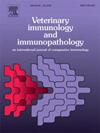黏附壳聚糖纳米疫苗在尼罗罗非鱼中抗迟达爱德华氏菌侵染的应用前景
IF 1.4
3区 农林科学
Q4 IMMUNOLOGY
引用次数: 0
摘要
用仿生黏附纳米疫苗浸泡接种已被证明可诱导对爱德华氏菌病的强烈粘膜免疫反应,爱德华氏菌病是尼罗罗非鱼由迟发爱德华氏菌引起的一种严重细菌性疾病。本研究旨在研究以β-葡聚糖(BG)为佐剂的壳聚糖纳米疫苗(CS)浸没递送对增强疫苗黏附性能的影响。通过扫描电镜(SEM)证实,制备的疫苗呈纳米球形,与福尔马林灭活疫苗相比,纳米疫苗的结合和穿透鳃的能力大大提高。选取12只( ± 2 g)尼罗罗非鱼,随机分为4组:对照组、福尔马林灭活疫苗组(阳性对照组)、壳聚糖/β-葡聚糖单药组(CS/BG)和壳聚糖/β-葡聚糖疫苗组(CS/BG V)。鱼在第1天和第21天浸泡,并给予30分钟的加强剂量。在接种疫苗后的两个时间间隔(14天和28天)收集样本,通过与对照组相比,接种疫苗的鱼的溶菌酶、髓过氧化物酶、NBT和超氧化物歧化酶活性显著升高来评估先天免疫反应(p <; 0.05)。ELISA测定的IgM抗体滴度与未接种疫苗组相比,在14和28Dpv处达到峰值。此外,qRT-PCR基因表达分析显示,接种后CS/BG V鱼脾脏IgM、TNF-α、IL-1β、TCR- β、MHC-I和IL-8均显著升高,抗体反应相似。36 Dpv后,通过用毒力强的迟达芽胞杆菌攻击鱼,进一步评估疫苗的效力,并观察15天的累积死亡率。结果表明,该疫苗在组内的保护率分别为24.44 %、37.78 %、48.89 %和68.89 %,且与对照组相比,C/BG V组的相对存活率(RPS)较高。四组头部肾、脾、鳃组织病理检查均见轻度浸润。这种壳聚糖纳米制剂,配以β-葡聚糖浸渍疫苗递送方法,将被证明对尼罗罗非鱼(Oreochromis niloticus)有效,显著影响水产养殖,并可能适用于全球水产养殖系统中的其他病原体。本文章由计算机程序翻译,如有差异,请以英文原文为准。
Mucoadhesive chitosan-based nano vaccine as promising immersion vaccine against Edwardsiella tarda challenge in Nile tilapia (Oreochromis niloticus)
Immersion vaccination with a biomimetic mucoadhesive nanovaccine has been shown to induce a strong mucosal immune response against Edwardsiellosis, a serious bacterial disease in Nile tilapia caused by Edwardsiella tarda. This study aims to develop and investigate the efficacy of immersion delivery using a chitosan nano-vaccine (CS) with β-glucan (BG) as an adjuvant to enhance the mucoadhesive properties of the vaccine. The prepared vaccines were nano-sized and spherical as confirmed by scanning electron microscope (SEM), and the images show that nano vaccine greatly increased the binding and penetrating ability into gills when compared with formalin-killed vaccine. Fingerling-sized Nile tilapia (12 ± 2 g) were randomly assigned to four groups: control, Formalin Killed vaccine (Positive control), Chitosan/β-glucan alone (CS/BG), and Chitosan/β-glucan Vaccine (CS/BG V). Fish received immersion baths on days 1 and 21 with a 30-min booster dose. Samples were collected at two time intervals (14, and 28 days post-vaccination (Dpv)) to evaluate innate immune responses through lysozyme, myeloperoxidase, NBT, and superoxide dismutase activity were significantly elevated in vaccinated fish compared to the control group (p < 0.05). IgM antibody titers, measured by ELISA, peaked at 14 and 28Dpv compared to the non-vaccinated group. Furthermore, after vaccination, gene expression analysis using qRT-PCR showed a significant increase in IgM, TNF-α, IL-1β, TCR- β, MHC-I, and IL-8 in the spleen of CS/BG V fishes, with similar antibody responses observed. The efficacy of the vaccine was further assessed by challenging the fish with virulent E. tarda after 36 Dpv, and observed 15 days for cumulative mortality. The results demonstrate that the vaccine showed significant protection of 24.44 %, 37.78 %, 48.89 % and 68.89 % respectively, in groups and high relative percentage survival (RPS) in the C/BG V group compared to the control group. Histopathological examinations of head kidney, spleen, and gills were performed for all four groups showed mild infiltrations. This chitosan nano formulation, adjuvanted with a β-glucan immersion vaccine delivery method, will prove effective for Nile tilapia (Oreochromis niloticus), significantly impacting aquaculture and potentially being applicable against other pathogens in global aquaculture systems.
求助全文
通过发布文献求助,成功后即可免费获取论文全文。
去求助
来源期刊
CiteScore
3.40
自引率
5.60%
发文量
79
审稿时长
70 days
期刊介绍:
The journal reports basic, comparative and clinical immunology as they pertain to the animal species designated here: livestock, poultry, and fish species that are major food animals and companion animals such as cats, dogs, horses and camels, and wildlife species that act as reservoirs for food, companion or human infectious diseases, or as models for human disease.
Rodent models of infectious diseases that are of importance in the animal species indicated above,when the disease requires a level of containment that is not readily available for larger animal experimentation (ABSL3), will be considered. Papers on rabbits, lizards, guinea pigs, badgers, armadillos, elephants, antelope, and buffalo will be reviewed if the research advances our fundamental understanding of immunology, or if they act as a reservoir of infectious disease for the primary animal species designated above, or for humans. Manuscripts employing other species will be reviewed if justified as fitting into the categories above.
The following topics are appropriate: biology of cells and mechanisms of the immune system, immunochemistry, immunodeficiencies, immunodiagnosis, immunogenetics, immunopathology, immunology of infectious disease and tumors, immunoprophylaxis including vaccine development and delivery, immunological aspects of pregnancy including passive immunity, autoimmuity, neuroimmunology, and transplanatation immunology. Manuscripts that describe new genes and development of tools such as monoclonal antibodies are also of interest when part of a larger biological study. Studies employing extracts or constituents (plant extracts, feed additives or microbiome) must be sufficiently defined to be reproduced in other laboratories and also provide evidence for possible mechanisms and not simply show an effect on the immune system.

 求助内容:
求助内容: 应助结果提醒方式:
应助结果提醒方式:


